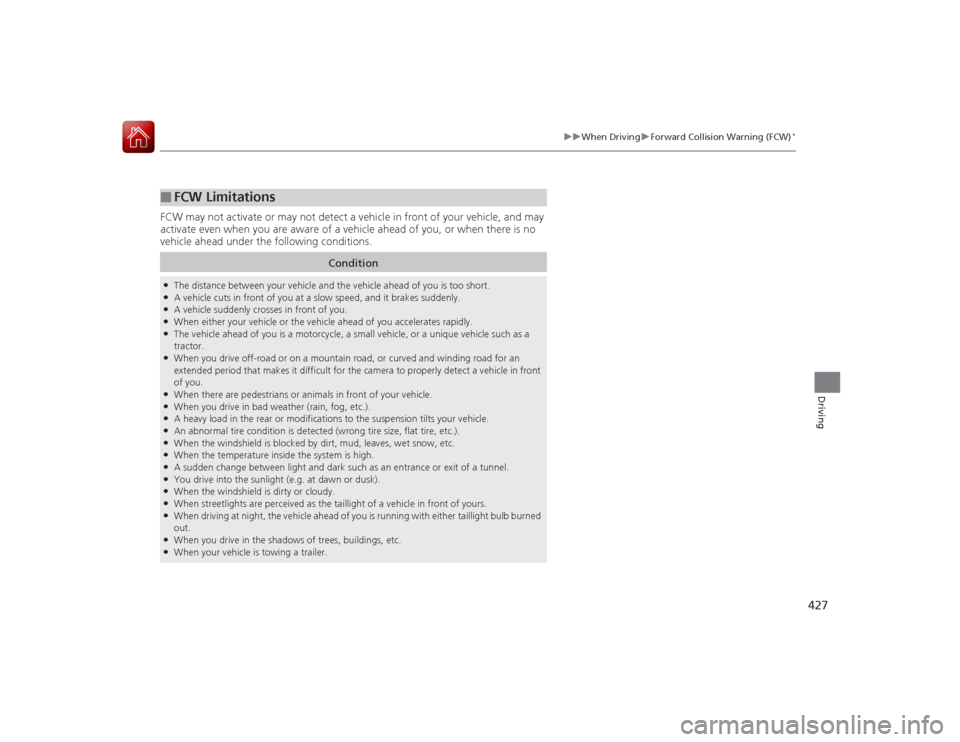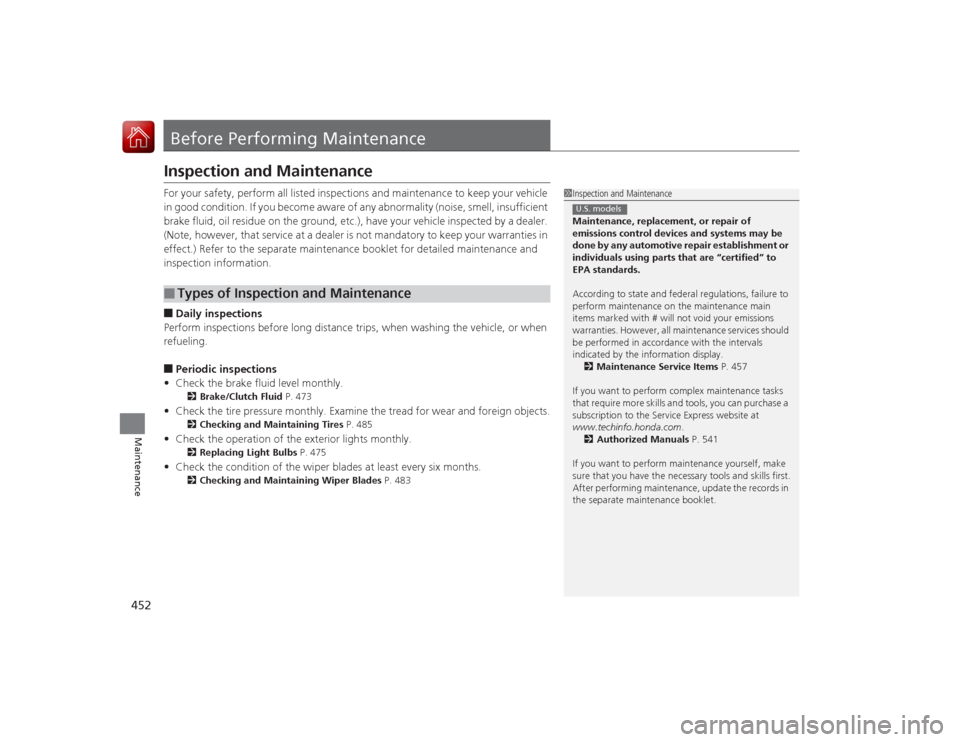2015 HONDA ACCORD COUPE bulb
[x] Cancel search: bulbPage 4 of 557

Contents
Child Safety P. 52Exhaust Gas Hazard P. 64Safety Labels P. 65Opening and Closing the Trunk P. 99 Security System P. 103 Opening and Closing the Windows P. 106
Operating the Switches Around the Steering Wheel P. 110 Adjusting the Mirrors P. 125
Interior Lights/Interior Convenience Items P. 135 Climate Control System P. 144Audio Error Messages P. 264General Information on the Audio System P. 270
Bluetooth® HandsFreeLink ® P. 314, 351 Compass
* P. 389
When Driving P. 401 Braking P. 440Parking Your Vehicle P. 444
Accessories and Modifications P. 450Maintenance Under the Hood P. 459 Replacing Light Bulbs P. 475
Checking and Maintaining Tires P. 485 Battery P. 494 Remote Transmitter Care P. 495
Cleaning P. 498Engine Does Not Start P. 511 Jump Starting P. 514Shift Lever Does Not Move P. 517
Fuses P. 524 Emergency Towing P. 527Devices that Emit Radio Waves P. 535 Reporting Safety Defects P. 536
Authorized Manuals P. 541 Customer Service Information P. 542
Quick Reference Guide
P. 4
Safe Driving
P. 27
Instrument Panel
P. 67
Controls
P. 85
Features
P. 149
Driving
P. 391
Maintenance
P. 451
Handling the Unexpected
P. 503
Information
P. 529
Index
P. 546
Page 74 of 557

73
uuIndicators u
Continued
Instrument Panel
*1:Models with the smart entry system have an ENGINE START/STOP button instead of an ignition switch.Indicator
Name
On/Blinking
Explanation
Electric Power
Steering (EPS)
System Indicator
●Comes on when you turn the ignition switch to
ON
(w
*1, and goes off when the engine starts.
●Comes on if there is a problem with the EPS
system.
●Stays on constantly or does not come on at
all - Have your vehicle checked by a dealer.
2 If the Electric Power Steering (EPS) System
Indicator Comes On P. 522
Low Tire
Pressure/TPMS
Indicator
●Comes on for a few seconds when you turn the
ignition switch to ON
(w
*1, then goes off.
●May come on briefly if the ignition switch is
turned to ON
(w
*1 and the vehicle is not moved
within 45 seconds, to indicate the calibration
process is not yet complete.
●Comes on and stays on when:
- One or more tires’ pressures are determined to
be significantly low.
- The system has not been calibrated.
●Comes on while driving - Stop in a safe
place, check tire pressures, and inflate the
tire(s) if necessary.●Stays on after the tires are inflated to the
recommended pressures - The system needs
to be calibrated.
2 TPMS Calibration P. 436
●Blinks for about one minute, and then stays on if
there is a problem with the TPMS, or when a
compact spare tire is temporarily installed.
●Blinks and remains on - Have your vehicle
checked by a dealer. If the vehicle is fitted with
a compact spare, get your regular tire repaired
or replaced and put back on your vehicle as
soon as you can.
Turn Signal and
Hazard Warning
Indicators
●Blinks when you operate the turn signal lever.●Blink along with all turn signals when you press
the hazard warning button.
●Does not blink or blinks rapidly - A turn
signal light bulb has blown. Change the bulb
immediately.
2 Replacing Light Bulbs P. 479, 481
Page 119 of 557

118
uuOperating the Switches Around the Steering Wheel uDaytime Running Lights
Controls
Daytime Running LightsThe high beam headlights come on slightly dimmer than normal when the following
conditions have been met:
The parking/daytime running lights come on when the following conditions have
been met:
• The ignition switch is in ON
(w
*1.
• The headlight switch is off, or in .
• The parking brake is released.
The lights remain on even if you set the parking brake. Turning off the ignition switch
or setting the power mode to VEHICLE OFF will turn off the daytime running lights.
The high beam headlights return to the original brightness once the headlight
switch is turned on.
*1: Models with the smart entry system have an ENGINE START/STOP button instead of an
ignition switch.Models with bulb type parking lightsModels with LED type parking/daytime running lightsModels with bulb type parking lights
Page 428 of 557

427
uuWhen Driving uForward Collision Warning (FCW)
*
Driving
FCW may not activate or may not detect a vehicle in front of your vehicle, and may
activate even when you are aware of a vehicle ahead of you, or when there is no
vehicle ahead under the following conditions.■
FCW Limitations
Condition
●The distance between your vehicle and the vehicle ahead of you is too short.●A vehicle cuts in front of you at a slow speed, and it brakes suddenly.●A vehicle suddenly crosses in front of you.●When either your vehicle or the vehicle ahead of you accelerates rapidly.●The vehicle ahead of you is a motorcycle, a small vehicle, or a unique vehicle such as a
tractor.●When you drive off-road or on a mountain road, or curved and winding road for an
extended period that makes it difficult for the camera to properly detect a vehicle in front
of you.●When there are pe destrians or animals in front of your vehicle.●When you drive in bad weather (rain, fog, etc.).●A heavy load in the rear or modifications to the suspension tilts your vehicle.●An abnormal tire condition is detected (wrong tire size, flat tire, etc.).●When the windshield is blocked by dirt, mud, leaves, wet snow, etc.●When the temperature inside the system is high.●A sudden change between light and dark such as an entrance or exit of a tunnel.●You drive into the sunlight (e.g. at dawn or dusk).●When the windshield is dirty or cloudy.●When streetlights are perceived as the taillight of a vehicle in front of yours.●When driving at night, the vehicle ahead of you is running with either taillight bulb burned
out.●When you drive in the shadows of trees, buildings, etc.●When your vehicle is towing a trailer.
Page 452 of 557

451
Maintenance
This chapter discusses basic maintenance.
Before Performing MaintenanceInspection and Maintenance ............ 452Safety When Performing Maintenance..... 453Parts and Fluids Used in Maintenance Service ........................................... 454
Maintenance Minder
TM..................... 455
Maintenance Under the Hood
Maintenance Items Under the Hood ..... 459Opening the Hood ........................... 461
Recommended Engine Oil ................ 463
Oil Check ......................................... 464
Adding Engine Oil ............................ 466Changing the Engine Oil and Oil Filter ..... 467
Engine Coolant ................................ 469
Transmission Fluid ............................ 471
Brake/Clutch Fluid ............................ 473
Refilling Window Washer Fluid......... 474
Replacing Light Bulbs ....................... 475Checking and Maintaining Wiper
Blades .......................................... 483Checking and Maintaining Tires
Checking Tires ................................. 485Tire and Loading Information Label ...... 486Tire Labeling .................................... 486DOT Tire Quality Grading (U.S. Vehicles)....... 488Wear Indicators................................ 490 Tire Service Life ................................ 490
Tire and Wheel Replacement ........... 491
Tire Rotation .................................... 492
Winter Tires ..................................... 493
Battery ............................................... 494
Remote Transmitter Care
Replacing the Button Battery ........... 495
Climate Control System Maintenance ... 497
Cleaning
Interior Care .................................... 498
Exterior Care.................................... 500
Page 453 of 557

452Maintenance
Before Performing MaintenanceInspection and MaintenanceFor your safety, perform all listed inspections and maintenance to keep your vehicle
in good condition. If you become aware of any abnormality (noise, smell, insufficient
brake fluid, oil residue on the ground, etc.), have your vehicle inspected by a dealer.
(Note, however, that service at a dealer is not mandatory to keep your \
warranties in
effect.) Refer to the separate maintenance booklet for detailed maintenance and
inspection information.■Daily inspections
Perform inspections before long distance trips, when washing the vehicle, or when
refueling.■Periodic inspections
• Check the brake fluid level monthly.2 Brake/Clutch Fluid P. 473
•Check the tire pressure monthly. Examine the tread for wear and foreign objects.
2 Checking and Maintaining Tires P. 485
•Check the operation of the exterior lights monthly.
2 Replacing Light Bulbs P. 475
•Check the condition of the wiper blades at least every six months.
2Checking and Mainta ining Wiper Blades P. 483
■
Types of Inspection and Maintenance
1Inspection and Maintenance
Maintenance, replacement, or repair of
emissions control devices and systems may be
done by any automotive repair establishment or
individuals using parts that are “certified” to
EPA standards.
According to state and federal regulations, failure to
perform maintenance on the maintenance main
items marked with # will not void your emissions
warranties. However, all maintenance services should
be performed in accordance with the intervals
indicated by the information display. 2 Maintenance Service Items P. 457
If you want to perform complex maintenance tasks
that require more skills and tools, you can purchase a
subscription to the Service Express website at
www.techinfo.honda.com .
2 Authorized Manuals P. 541
If you want to perform maintenance yourself, make
sure that you have the necessary tools and skills first.
After performing maintenance, update the records in
the separate maintenance booklet.U.S. models
Page 476 of 557

475
Continued
Maintenance
Replacing Light BulbsHeadlight BulbsWhen replacing, use the following bulbs.1.Unlock the holding clips, then remove the
upper part of the air intake duct and the air
intake tube.
1. Remove the reserve tank.High beam headlight:
60 W (HB3 for halogen bulb type)
Low beam headlight:
LED type
*
Low beam headlight:
55 W (H11 for halogen bulb type)
*
■
High Beam Headlight
1Headlight BulbsNOTICEHalogen bulbs get very hot when lit.
Oil, perspiration, or a scratch on the glass can cause
the bulb to overheat and shatter.
The headlight aim is set by the factory, and does not
need to be adjusted. However, if you regularly carry
heavy items in the trunk or tow a trailer, have the
aiming readjusted at a dealer or by a qualified
technician.
When replacing a halogen bulb, handle it by its base,
and protect the glass from contact with your skin or
hard objects. If you touch the glass, clean it with
denatured alcohol and a clean cloth.
Tube
Holding Clip
Holding Clips
Driver side6-cylinder modelsPassenger sideAll models
* Not available on all models
Page 477 of 557

uuReplacing Light Bulbs uHeadlight Bulbs
476Maintenance
2. Push the tab to remove the coupler.
3. Rotate the old bulb to the left to remove.
4. Insert a new bulb into the headlight
assembly and turn it to the right.
5. Insert the coupler into the connector of the
bulb.
1High Beam Headlight
Press down the center pin until it clicks to unlock it.
Push the center pin back to lock the clip. Then, insert
the clip into the hole and press on the center pin until
it is flat.Holding clip
Center pin
Push until
the pin is
flat.
Tab
Coupler
Bulb